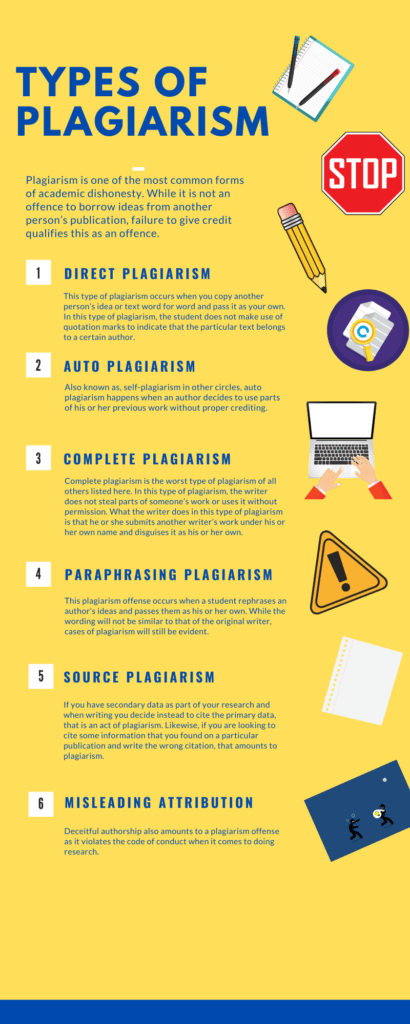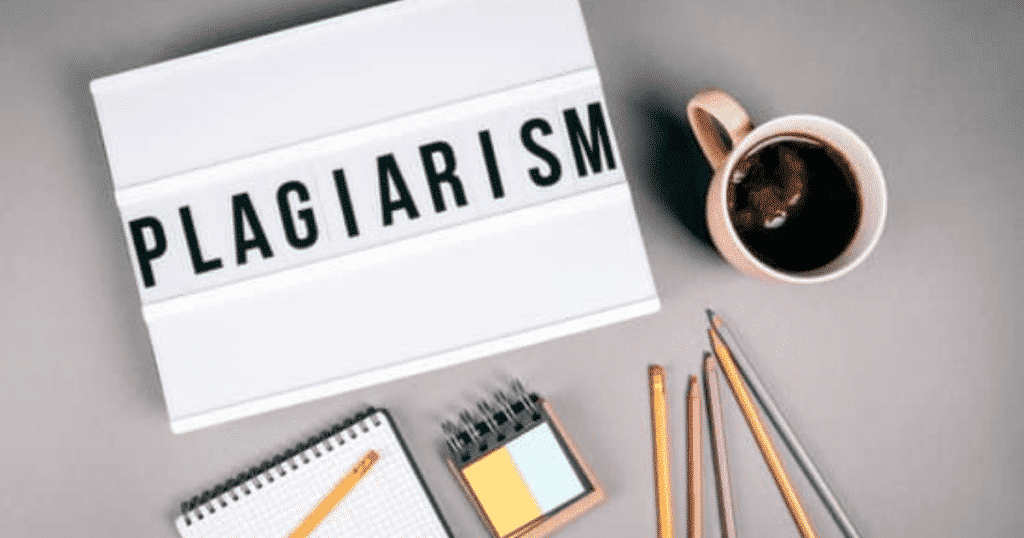Plagiarism refers to the representation of another person’s ideas as your own. What types of plagiarism are there?
There is only one way to find out,
While it is not an offence to borrow ideas from another person’s publication, failure to give credit qualifies this as an offence.
Plagiarism is one of the most common forms of academic dishonesty. Sometimes, plagiarism occurs unintentionally.

Nevertheless, even in this case, it still counts as an offence. Knowing the types of plagiarism available allows you to prevent committing plagiarism with more success. Also, using a plagiarism checker to go through your work before you submit it can help you avoid committing the offence.
This post looks at some of the most common types of plagiarism. They include:
- Direct Plagiarism
- Auto Plagiarism
- Complete Plagiarism
- Paraphrasing Plagiarism
- Source Plagiarism
- Misleading Attribution
Types of Plagiarism
Direct Plagiarism
This type of plagiarism occurs when you copy another person’s idea or text word for word and pass it as your own.
In these types of plagiarism, the student does not make use of quotation marks to indicate that the particular text belongs to a certain author.
Additionally,
If the student fails to mention that the text is the original work of another author, this constitutes direct plagiarism.
Direct plagiarism, however, does not constitute the use of the entire text from another author’s work.
Direct plagiarism or verbatim plagiarism only refers to the use of parts of another author’s work.
Below is an example of direct plagiarism.
In this case, the writer should have written;
A decade ago, a majority of employment services would have said that having tattoos would eradicate your chances of getting a job opportunity. Circumstances are different now. These days, more than 33% of the youth have various tattoos and body art.
They can also cite the source of the original work to acknowledge the author.
Auto Plagiarism
Also known as, self-plagiarism in other circles, auto plagiarism happens when an author decides to use parts of his or her previous work without proper crediting.
While this is not a common form of plagiarism among students, it still happens.
Some students use parts of a previous essay to illustrate a point in the current essay they are handling without proper crediting.
It is important to cite your own work well or ask for permission to use the same from professors that took part in approving that particular paper.
Auto plagiarism can also occur if a student submits a previously done paper in place of the current paper they are handling.
An example of auto plagiarism would happen if a student John wrote an essay in high school on the effects of drug abuse on teens in Brooklyn.
When he joins colleges, he gets a similar assignment and instead of writing a new essay, he submits the previous essay he wrote in high school.
In this case, the writer should avoid using the same essay on different assignments. They can instead, do some research and write a new article while using the old one as a reference or ask for help doing the assignment. If you use some points on your old essay, ensure you cite the paper.
Complete Plagiarism
Complete plagiarism is the worst type of plagiarism of all others listed here. In this type of plagiarism, the writer does not steal parts of someone’s work or uses it without permission.
What the writer does in this type of plagiarism is that he or she submits another writer’s work under his or her own name and disguises it as his or her own.
These types of plagiarism can attract harsh penalties as it amounts to intellectual theft.
To prevent cases of complete plagiarism, it is advisable to write your own academic papers based on your own research.
Below is an example of complete plagiarism.
The writer should have written;
According to Wikipedia, before the first World War, SPD was the biggest party in Germany. It was also the world’s best socialist party.
In Hogwoord’s journal, Reconstructing identity in post-communist Germany, he states, the last form can support itself as a live and enduring expression of separate easterners with an integrated Germany.
To fully avoid plagiarism, the writer should acknowledge the original author. Either cite the source or mention them in the paper.
Paraphrasing Plagiarism
This plagiarism offence occurs when a student rephrases an author’s ideas and passes them as his or her own.
While the wording will not be similar to that of the original writer, cases of plagiarism will still be evident.
The reason for this is that the words may be different but the core idea remains.
The fact that the writer uses the original idea without giving credit to its owner amounts to plagiarism.
Paraphrasing plagiarism is a very common form of plagiarism among many students in the USA.
Below is an example of paraphrasing plagiarism.
If you’re paraphrasing someone else’s words, ensure you give them credit in your work. In this case, the writer should have written,
According to the leaves of grass criticism, Black, in the 1987 edition, Whitman started the restless arranging and sorting of poems that would keep him busy for the rest of his life. Seemingly, he sought an external conscious structure to answer critics who said his work was unclear. In this case, since the writer mentioned the origin of his information it cancels out plagiarism.
Black, S (1988), ‘“Leaves of Grass” Criticism.
Source Plagiarism
You may make an effort to cite your work but still end up committing an act of plagiarism. How so? This is how it happens.
If you have secondary data as part of your research and when writing you decide instead to cite the primary data, that is an act of plagiarism.
Likewise, if you are looking to cite some information that you found on a particular publication and write the wrong citation, that amounts to plagiarism.
Lastly, source-based plagiarism occurs when you modify data to present some desirable outcome that was not the same in the original publication.
The writer has to correctly cite the source of information to avoid the risk of these types of plagiarism. There are many free tools online which can help you make more accurate citations.
Misleading Attribution
Deceitful authorship also amounts to a plagiarism offence as it violates the code of conduct when it comes to doing research.
This type of plagiarism can occur in several ways.
First,
A student may fail to give attribute to a researcher who contributed to the research published in the paper.
This act shows a lack of honesty and appreciation for someone’s intellectual input in that particular paper and thus counts as plagiarism.
The second means by which a student may commit this type of plagiarism is by including a contributor falsely.
This practice happens mostly among students when they include their friends as contributors to a research paper when they did not take part in its research and publication.
Thirdly, false authorship that leads to plagiarism occurs during editing. In this instance, a student may ask an editor to help polish the paper.
By doing this, an editor may change parts of the paper, which makes it significantly different from the original paper.
Instead, a student should list the editor among the contributors to that paper. Failure to do so results in plagiarism.
Below is an example of deceitful authorship that leads to plagiarism.
In this case, the writer has to cite everyone who contributed to the article. The writer should have written;
One of many ambitious novels by Steinbeck since The Grapes of Wrath is East of Eden (1952), sold poorly but was well placed.
Horberger, T (1966) the literature of the United States 2, 3rd edition, 1282.
How To Avoid Plagiarism- Types of Plagiarism
Avoiding plagiarism is easy and it is advisable for every student to make an effort to ensure that no instance of plagiarism exists in his or her academic paper.
Here are some tips on how to avoid plagiarism.
- List all your sources
- Follow citation guidelines
- Use a plagiarism checker
List All Your Sources
It is advisable that as a precaution against committing different types of plagiarism, you list down all your sources as you go about researching your topic.
This list comes in handy when it is time to cite your sources.
Follow Citation Guidelines
It is important that you ask about the citation format that your school recommends for use.
Additionally, make an effort of learning how to cite properly using that particular citation style.
Use A Plagiarism Checker
Using a plagiarism checker to check your work before submitting is highly effective in helping you submit a plagiarism-free paper.
Make any changes that the checker recommends before submitting your paper for the final evaluation.
Conclusion
Plagiarism is illegal and punishable by law. It is a form of theft or fraud since it involves taking someone’s ideas and passing them as your own without properly crediting the original author.
To ensure your article is free from different types of plagiarism, you should keep track of the sources you use in your research. You can cite them in your article later.
Ensure you pass your work through a plagiarism checker to help you identify some areas you missed citing. Before writing an article, ensure you conduct proper research. Express your ideas without getting them influenced by another. If you must use someone else’s idea, ensure you give credit to the original author.

Share This Infographic With Your Audience
What are the 10 types of plagiarism?
They include clone plagiarism, remix plagiarism, hybrid plagiarism control and paste plagiarism, find and replace, recycle and mashup plagiarism
What is plagiarism and types of plagiarism?
This means using someone else words or ideas in your work
What is the most common form of plagiarism?
The most common types of plagiarism include direct plagiarism and mosaic plagiarism i.e failure to quote the original author
What is direct plagiarism?
Copying another person’s work without acknowledging them



